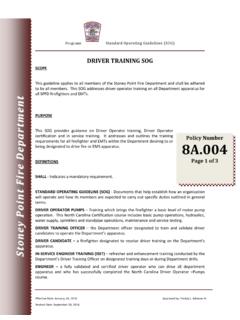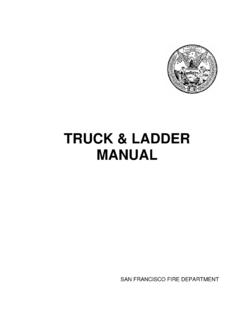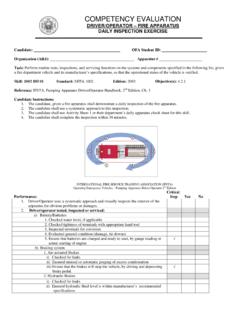Transcription of Operational Training Guidance - Breathing Apparatus
1 F Operational Training Guidance - Breathing Apparatus Crown copyright, 2013 Copyright in the typographical arrangement rests with the Crown. You may re-use this information (not including logos) free of charge in any format or medium, under the terms of the Open Government Licence. To view this licence, or write to the Information Policy Team, The National Archives, Kew, London TW9 4DU, or email: This document/publication is also available on our website at If you have any enquiries regarding this document/publication, email or write to us at: Department for Communities and Local Government Eland House Bressenden Place London SW1E 5DU Telephone: 030 3444 0000 April 2013 ISBN - 978-1-4098-3843-2 Contents 1 Foreword 4 2 Preface 6 3 Introduction Purpose 8 Scope 8 Structure 9 4 Legal framework Introduction 11 Specific legislation 12 Other Guidance 13 5 Strategic role of Operational Training Guidance Strategic perspective 15 Values 16 Operational Training Guidance review protocols 16 6 Breathing Apparatus Role Related Training Operational Breathing Apparatus related roles 18 Acquisition of Breathing Apparatus role related competence 19
2 Maintenance of Breathing Apparatus role related competence 19 Active monitoring of Breathing Apparatus role related competence through assessment 20 Reducing the risk to personnel engaged in Breathing Apparatus Training 20 7 Appendices 1. Obsolete or superseded Breathing Apparatus Operational Training Guidance 22 2. Breathing Apparatus role specific leaning outcome example 23 8 Glossary of terms 41 4 Foreword fire and rescue service personnel operate in dynamic and at times extremely hazardous environments incidents involving fire , chemicals, biological hazards, radiation and acts of terrorism. The wearing of Breathing Apparatus by personnel is one of the risk control measures likely to be employed within the overall Operational plan for incidents of this type.
3 Breathing Apparatus enables the wearer to breathe safely in an otherwise irrespirable and/or toxic atmosphere. The fire and Rescue Operational Training Guidance Breathing Apparatus - provides robust yet flexible Guidance that supports the Operational competency of personnel that are required to wear, manage or train others in the use of Breathing Apparatus in order to meet the requirements of a fire and rescue authority s Integrated Risk Management Plan. It aims therefore to provide a consistent approach throughout the fire and rescue service and forms the basis for common Operational practices, supporting interoperability and resilience across fire and rescue services, other emergency services and where appropriate, industry.
4 The Guidance has been prepared as a guide for fire authorities, chief fire officers, chief executives, and those persons within fire and rescue services with responsibility for firefighter safety. It is intended for use as a practical guide to the considerations they should make in meeting their duties and responsibilities. Accordingly, employee safety representatives should also find it helpful. Whilst addressing the legislative requirements placed on duty holders, the main focus of this Guidance is the health and safety at work of all fire and rescue service personnel required to use Breathing Apparatus . This Guidance sets a benchmark in the form of good practice against which fire and rescue authorities can measure their existing management systems and arrangements.
5 The Health and Safety Executive, Trade Union Safety Representatives and others, such as independent auditors and Operational assessment peer review teams, may also reference the Guidance when auditing fire and rescue authorities arrangements for managing the health, safety and welfare of Operational personnel. 5 This Guidance has been developed with the support and input of the: Chief fire and Rescue Adviser Health and Safety Executive The fire Brigades Union and other representative bodies Chief fire Officers Association Devolved administrations fire Service College This Guidance is issued by the Chief fire and Rescue Adviser. Following this Guidance is not compulsory and you are free to take other action.
6 But if you do follow the Guidance you will normally be doing enough to comply with the law and service agreements. It has not been given the official status of an approved code of practice but it does set out Guidance to fire and rescue services to assist them in applying health and safety legislation to the Operational environment. The Chief fire and Rescue Adviser is grateful for the assistance in the development in this Guidance from a wide range of external partners. The drive toward common principles, practices and procedures supports the development of safe systems of work on the incident ground and enhances intra and inter operability and national resilience. 6 Preface fire and Rescue Service Operational Training Guidance issued by the Department of Communities and Local Government promotes and develops good practice within the fire and rescue service and is offered as a current industry standard.
7 It is envisaged that this will help establish high standards of efficiency and safety in the interests of employers, employees and the general public. It is recommended that each service utilises this Guidance and the fire and Rescue Service Health, Safety and Welfare Framework to assure the Breathing Apparatus Training and competence of their Operational personnel. It is a matter for each individual fire and rescue service whether to adopt and follow this Operational Training Guidance . The onus of responsibility for application of Guidance lies with the user. Department of Communities and Local Government accept no legal liability or responsibility whatsoever, howsoever arising, for the consequences of the use or misuse of the Guidance Introduction SECTION 3 8 Purpose This Operational Training Guidance has been developed using the fire and rescue service Health, Safety and Welfare Framework and the principles of the Health & Safety Guidance 65 (HSG 65) Successful Health and Safety Management.
8 It provides a framework for how a service can discharge its duty of care for the Training and the assurance of competence for Operational personnel who undertake one of the following roles: Breathing Apparatus wearers Incident commanders / incident monitoring officers Breathing Apparatus trainers / instructors This Guidance replaces a number of historic Breathing Apparatus Operational Training Guidance (appendix 1) in the form of fire Service Circulars and Dear Chief Officer Letters. Scope This Guidance presents a framework for the acquisition and maintenance of competence for Breathing Apparatus wearers, personnel responsible for the command and control of Breathing Apparatus at Operational incidents and the personnel that develop and train others to be able to undertake these roles competently.
9 It aims therefore to provide a consistent approach across fire and rescue services and forms the basis for common Operational practices, supporting interoperability across fire and rescue services, other emergency services and where appropriate, industry and other groups. The drive toward common principles, practices and procedures supports the development of safe systems of work on the incident ground and enhances national resilience. 9 Structure This Guidance provides services with a clear framework for each of the three Breathing Apparatus roles identified on page 8 and should be utilised to ensure Operational personnel acquire and maintain the required level of competence for their role. 10 Legal framework 11 Introduction fire and rescue authorities need to be aware of the following legislation.
10 It is relevant to the Training and competence of Operational personnel who either use or manage/monitor the use of Breathing Apparatus at Operational incidents. This section does not contain detailed legal advice about the legislation; it is just a summary of the relevant legislation, as applied to fire and rescue authorities, firefighters and Breathing Apparatus as an item of respiratory protective equipment. fire and rescue authorities, may wish to seek further legal advice to confirm their compliance with this framework. When considering this framework it is essential to recognise that any definitive interpretation of the legal roles and responsibilities imposed by legislation can only be given by a court of law. General fire and Rescue Services legislation fire and Rescue Services Act 2004: this is the main Act which affects fire and rescue authorities.



















